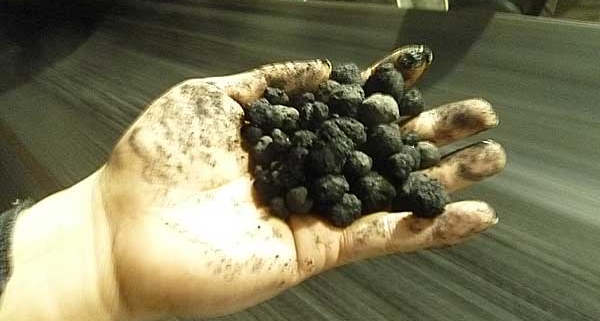China has a lot of small and medium-sized paper mills with straw as raw material, but the problem of black liquor pollution has not been solved very well. The previously proposed alkali recovery black liquor treatment measures, due to large investment, are generally difficult for medium and small paper mills to bear. In addition, there are many processes, complicated operation and operation, and it is difficult to meet environmental emission standards. The practical results show that it is difficult to promote and apply.
In recent years, Wuxi Linzhou Drying Machine Factory, China Academy of Forestry Science and Technology Research Institute and Nanjing Forestry University have been working hard to explore and introduce the black liquor resource utilization method, that is, to separate the black liquor solid and liquid into lignin. Dry powder of sulfonate. The technology is characterized by high technology content, advanced engineering technology, simple process flow, low investment, and the recycled lignosulfonate has a wide range of uses and good economic benefits. After the completion of the project, not only can the papermaking black liquor be converted into products, but there is no wastewater discharge port in the project area, no secondary pollution, good pollution control effect, good environmental and economic benefits. In particular, due to the current black liquor pollution can not be resolved, a number of small paper mills have been forcibly shut down, and many existing paper mills are facing a production crisis due to pollution problems. The application of pulping black liquor resource treatment engineering technology will undoubtedly bring hope for re-survival to these plants.
The preparation of lignosulfonate from black liquor is technically mature. There are fifteen paper mill users in Wuxi Linzhou Drying Machine Factory, and there is no problem in equipment manufacturing supply. Many paper mills now want to solve the problem of black liquor pollution as soon as possible, but it is difficult to solve problems due to funding and other issues, resulting in the failure of the governance project. Now with the black liquor resource management method, the by-product lignosulfonate produced at the same time can obtain good economic benefits, and the equipment investment cost can be recovered within a few years. Therefore, if the financing channels can be properly solved and the cooperation between the factory and the technical design parties and equipment manufacturers, this will be a very good and promising investment project.
Black liquor resource management technology program
First, the cause of papermaking black liquor
The wastewater produced during the non-wood fiber (straw) papermaking process is:
1. The waste liquid (ie black liquor) remaining after the steamed pulp stock solution is subjected to pressure filtration. 2. Separate the rinse water produced by the concentrate.
3. White water produced by the paper machine.
The white water produced by the paper machine can be reused after treatment, but the black liquor and rinse water cannot be recycled. This part of the water accounts for more than 90% of the total discharge of pollutants in the paper mill. After the waste liquid is discharged, it will seriously pollute the environment, so direct discharge is strictly prohibited.
Second, black liquor ingredients
The straw used in papermaking raw materials contains cellulose, lignin and hemicellulose (glycans). The paper is only used for cellulose (about 40%), and about 25% of the lignin and About 28% of hemicellulose and xylose, potassium, nitrogen, phosphorus, etc., are discarded with black liquor. The lignin, hemicellulose, and xylose, potassium, nitrogen, and phosphorus contained in the black liquor are highly valuable in industrial and agricultural production.
Third, technical scheme for recycling black liquor of papermaking
Slurry separation→Evaporation and concentration (middle stage sulfonation reaction)→Spray drying Slurry separation: After removing the impurities from the original slurry, the double-layer slurry extruder with “three-crush and two-replacement” function makes the black liquor extraction rate ≥90 %, the concentration of black liquor is about 8~10%, and the black liquor is extracted ≤10m3/t pulp;
Evaporation and concentration: the black liquor after slurry separation has a concentration of about 8~10%. The concentration after evaporation and concentration by the high-efficiency energy-saving horizontal spray evaporation device is about 40%. During the evaporation process, the steam condensation water generated by the evaporator heat source can be used. The boiler is replenished with water or used in production. The evaporating condensed water in the concentration process can be reused without sewage discharge; the middle part of the evaporation and concentration is subjected to sulfonation reaction through a high pressure reaction kettle;
Spray drying: The concentrated black liquor is spray-dried by a high-speed centrifugal spray dryer to obtain a lignosulfonate product, which has a wide range of uses.
Fourth, the status quo of other papermaking black liquor treatment technology
1.1 alkali recovery method
The traditional alkali recovery technology uses a concentration-combustion-caustic process to recover the alkali and recycle it. The alkali recovery rate of large wood pulp and paper mills is up to 90%, and the alkali recovery rate of non-wood raw material pulp mills (rice, wheat straw, reed, sucrose residue, etc.) can reach more than 70%. The use of alkali recovery can greatly reduce the high-load pollution of black liquor, BOD5 can be reduced by 80% to 85%, in addition to the recovery of thermal chemicals to reduce costs and increase economic benefits.
The advantage of this method is that the organic matter in the black liquor is burned to produce steam for use by the factory, there is no market sales problem; the pollution load of about 80% of the whole plant can be reduced; more than 50% of caustic soda can be recovered, which is a thorough pollution. Governance technology. For small and medium-sized straw pulp enterprises, this method has certain shortcomings: the project investment and operation cost are high, and the pulp mill with an annual output of more than 17,000 tons can achieve low profit operation; wheat straw black liquor has low calorific value, high viscosity and silicon content. The high volume makes the alkali recovery cost high, the alkali recovery rate is low, the operation is difficult, and the processes such as causticization and combustion still need to be improved, otherwise it will not operate normally.
1.2 Physical Chemistry
1.2.1 Acid precipitation method
After extracting the black liquor through the microfilter to remove the fine fibers, the lignin separator is added to the acid solution to control the pH value, and the lignin is precipitated and dehydrated by heating and pressure filtration to become a lignin product. The method has a CODCr removal rate of 80%, an SS removal rate of about 85%, a chroma removal rate of 95%, and a lignin recovery rate of about 80%, which has a significant effect on reducing organic dye loading. The advantage of this method is that the process is simple, the investment is small, and the lignin is recovered while reducing the dyeing load of the organic matter. At the same time, there are a series of shortcomings: technically, the equipment is seriously corroded, lignin is difficult to filter and dehydrate; the residual liquid after the process can not meet the discharge standard, and it is acidic and needs further treatment; economically, the cost of acid must be reduced, and at the same time There are sales problems in the products.
1.2.2 Coagulation sedimentation method
After the black liquor is acidified, the flocculant is added to the coagulation and sedimentation. After the solid-liquid separation, the sediment is incinerated as a fuel, and the filtrate is partially adsorbed and filtered for reuse in the pulping section, and the rest is discharged into the middle section wastewater. The initial investment of this method is relatively low, and it is suitable for small paper mills with an annual output of less than 10,000 tons. However, there are many shortcomings: the treatment is not complete, the treatment rate of BOD5 is only about 20%; the amount of sludge generated is large, the dehydration is difficult, and the treatment is Difficult, it is actually a method of pollution transfer; operating costs are sensitive to flocculant prices, and annual operating costs are high.
1.3 Anaerobic biological treatment
After the pretreatment of the straw black liquor, the anaerobic treatment process is used to reduce the CODCr and recover some of the biogas energy. Anaerobic processes generally use more efficient AFB (anaerobic fluidized bed), UASB (anaerobic sludge bed) or ABR (anaerobic baffled reactor) with two-phase anaerobic characteristics, CODCr removal rate is generally It is about 50%. When the conditions are met, the papermaking black liquor can be mixed with other wastes and liquids to achieve the effect of mutual utilization and waste disposal. Compared with the aerobic biological method, the anaerobic treatment of high-concentration organic wastewater has its unique advantages: it can recover energy in the form of biogas, the sludge production is low, and the initial degradation of complex organic matter is beneficial to the subsequent process. The main disadvantages are: sensitive to toxic substances in the wastewater; the treatment is not thorough enough, there must be a follow-up process to enable the sewage to reach the standard discharge; the operation management is relatively complicated, and the alkali cannot be recovered.
1.4 Comprehensive utilization method
1.4.1 Resource Management
The lignin is extracted by acid precipitation and the lignin product is obtained. The supernatant is lime-calculated to separate the calcium salt and the alkaline solution, the calcium salt is used as a building material raw material, and the alkaline solution is concentrated by evaporation to obtain a sugar slurry product. The evaporated condensed water is completely recovered and used for vacuum washing, so that the black liquor is all utilized to achieve zero discharge. Resource management has the advantages of turning waste into treasure, the equipment is simpler, and the system operation is relatively stable; but in order not to affect the pulp quality, the alkaline liquid reuse rate cannot exceed 25%, resulting in a corresponding alkali recovery rate of only 5%. The various products generated during the process have more impurities and no comprehensive utilization value, and need to be further processed.
1.4.2 Resource utilization
Directly use black liquor of straw pulp to produce black liquor coal water slurry, obtain thermal energy through combustion, exhaust gas after combustion reaches the standard, residue can be used as building materials; or black liquor can be changed by chemical method Sex, used as a drilling mud viscosity reducer; another research direction is to extract lignin in black liquor, which is chemically modified to become a chemical raw material, which can be made into water reducing agent, asphalt emulsifier and water treatment agent. Etc. There have been a lot of research results on this.
The resource utilization of black liquor has broadened the thinking of black liquor pollution control, and enterprises can fully apply it according to actual conditions. Annual production of 10,000 tons of pulp and paper enterprises, using traditional alkali recovery technology, annual loss of 110-1.4 million yuan; scale expansion to annual output of more than 17,000 tons, can maintain low-profit operation; scale greater than 25,000 tons, alkali recovery process The annual profit for the enterprise is more than 2 million yuan, and the economic benefit of alkali recovery is positively related to the scale of the enterprise. The benefits of SO2 acid precipitation, acid precipitation + anaerobic process and resource management all depend on the sales and price of lignin produced. It is of great significance to develop and promote the market application of lignin. Although the LB_1 alkali precipitation method is simple in equipment and convenient in operation, the alkali recovery rate is only 5%, and the recovered lignin impurities are numerous, and there is no comprehensive utilization value, and it can only be used as a transitional measure for reducing the black liquor of the straw pulp.



